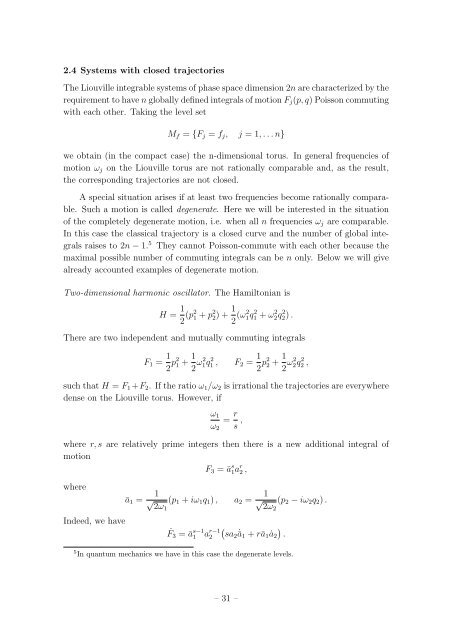Student Seminar: Classical and Quantum Integrable Systems
Student Seminar: Classical and Quantum Integrable Systems
Student Seminar: Classical and Quantum Integrable Systems
Create successful ePaper yourself
Turn your PDF publications into a flip-book with our unique Google optimized e-Paper software.
2.4 <strong>Systems</strong> with closed trajectories<br />
The Liouville integrable systems of phase space dimension 2n are characterized by the<br />
requirement to have n globally defined integrals of motion F j (p, q) Poisson commuting<br />
with each other. Taking the level set<br />
M f = {F j = f j , j = 1, . . . n}<br />
we obtain (in the compact case) the n-dimensional torus. In general frequencies of<br />
motion ω j on the Liouville torus are not rationally comparable <strong>and</strong>, as the result,<br />
the corresponding trajectories are not closed.<br />
A special situation arises if at least two frequencies become rationally comparable.<br />
Such a motion is called degenerate. Here we will be interested in the situation<br />
of the completely degenerate motion, i.e. when all n frequencies ω j are comparable.<br />
In this case the classical trajectory is a closed curve <strong>and</strong> the number of global integrals<br />
raises to 2n − 1. 5 They cannot Poisson-commute with each other because the<br />
maximal possible number of commuting integrals can be n only. Below we will give<br />
already accounted examples of degenerate motion.<br />
Two-dimensional harmonic oscillator. The Hamiltonian is<br />
H = 1 2 (p2 1 + p 2 2) + 1 2 (ω2 1q 2 1 + ω 2 2q 2 2) .<br />
There are two independent <strong>and</strong> mutually commuting integrals<br />
F 1 = 1 2 p2 1 + 1 2 ω2 1q 2 1 , F 2 = 1 2 p2 2 + 1 2 ω2 2q 2 2 ,<br />
such that H = F 1 +F 2 . If the ratio ω 1 /ω 2 is irrational the trajectories are everywhere<br />
dense on the Liouville torus. However, if<br />
ω 1<br />
ω 2<br />
= r s ,<br />
where r, s are relatively prime integers then there is a new additional integral of<br />
motion<br />
F 3 = ā s 1a r 2 ,<br />
where<br />
ā 1 = 1 √ 2ω1<br />
(p 1 + iω 1 q 1 ) , a 2 = 1 √ 2ω2<br />
(p 2 − iω 2 q 2 ) .<br />
Indeed, we have<br />
( )<br />
F˙<br />
3 = ā s−1<br />
1 a r−1<br />
2 sa2 ˙ā 1 + rā 1 ȧ 2 .<br />
5 In quantum mechanics we have in this case the degenerate levels.<br />
– 31 –

















